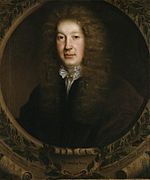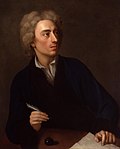Related Research Articles

Alexandrine is a name used for several distinct types of verse line with related metrical structures, most of which are ultimately derived from the classical French alexandrine. The line's name derives from its use in the Medieval French Roman d'Alexandre of 1170, although it had already been used several decades earlier in Le Pèlerinage de Charlemagne. The foundation of most alexandrines consists of two hemistichs (half-lines) of six syllables each, separated by a caesura :
o o o o o o | o o o o o o o=any syllable; |=caesura
In poetry, a couplet is a pair of successive lines that rhyme and have the same metre. A couplet may be formal (closed) or run-on (open). In a formal (closed) couplet, each of the two lines is end-stopped, implying that there is a grammatical pause at the end of a line of verse. In a run-on (open) couplet, the meaning of the first line continues to the second.
In poetry, enjambment is incomplete syntax at the end of a line; the meaning 'runs over' or 'steps over' from one poetic line to the next, without punctuation. Lines without enjambment are end-stopped. The origin of the word is credited to the French word enjamber, which means 'to straddle or encroach'.
Hexameter is a metrical line of verses consisting of six feet. It was the standard epic metre in classical Greek and Latin literature, such as in the Iliad, Odyssey and Aeneid. Its use in other genres of composition include Horace's satires, Ovid's Metamorphoses, and the Hymns of Orpheus. According to Greek mythology, hexameter was invented by Phemonoe, daughter of Apollo and the first Pythia of Delphi.
In poetry, metre or meter is the basic rhythmic structure of a verse or lines in verse. Many traditional verse forms prescribe a specific verse metre, or a certain set of metres alternating in a particular order. The study and the actual use of metres and forms of versification are both known as prosody.

Poetry, also called verse, is a form of literature that uses aesthetic and often rhythmic qualities of language − such as phonaesthetics, sound symbolism, and metre − to evoke meanings in addition to, or in place of, a prosaic ostensible meaning. A poem is a literary composition, written by a poet, using this principle.
A quatrain is a type of stanza, or a complete poem, consisting of four lines.
Rhyme royal is a rhyming stanza form that was introduced to English poetry by Geoffrey Chaucer. The form enjoyed significant success in the fifteenth century and into the sixteenth century. It has had a more subdued but continuing influence on English verse in more recent centuries.
Mock-heroic, mock-epic or heroi-comic works are typically satires or parodies that mock common Classical stereotypes of heroes and heroic literature. Typically, mock-heroic works either put a fool in the role of the hero or exaggerate the heroic qualities to such a point that they become absurd.

The Tale of Kiều is an epic poem in Vietnamese written by Nguyễn Du (1765–1820), considered the most famous poem and a classic in Vietnamese literature. The original title in Vietnamese is Đoạn Trường Tân Thanh, but it is better known as Truyện Kiều.
Iambic pentameter is a type of metric line used in traditional English poetry and verse drama. The term describes the rhythm, or meter, established by the words in each line. Rhythm is measured in small groups of syllables called "feet". "Iambic" indicates that the type of foot used is the iamb, which in English is an unstressed syllable followed by a stressed syllable. "Pentameter" indicates that each line has five "feet".

Heroic verse is a term that may be used to designate epic poems, but which is more usually used to describe the meter(s) in which those poems are most typically written. Because the meter typically used to narrate heroic deeds differs by language and even within language by period, the specific meaning of "heroic verse" is dependent upon context.

Restoration literature is the English literature written during the historical period commonly referred to as the English Restoration (1660-1688), which corresponds to the last years of Stuart reign in England, Scotland, Wales, and Ireland. In general, the term is used to denote roughly homogenous styles of literature that centre on a celebration of or reaction to the restored court of Charles II. It is a literature that includes extremes, for it encompasses both Paradise Lost and the Earl of Rochester's Sodom, the high-spirited sexual comedy of The Country Wife and the moral wisdom of The Pilgrim's Progress. It saw Locke's Treatises of Government, the founding of the Royal Society, the experiments and holy meditations of Robert Boyle, the hysterical attacks on theatres from Jeremy Collier, and the pioneering of literary criticism from John Dryden and John Dennis. The period witnessed news becoming a commodity, the essay developing into a periodical art form, and the beginnings of textual criticism.

Heroic drama is a type of play popular during the Restoration era in England, distinguished by both its verse structure and its subject matter. The subgenre of heroic drama evolved through several works of the middle to later 1660s; John Dryden's The Indian Emperour (1665) and Roger Boyle's The Black Prince (1667) were key developments.
This is a glossary of poetry terms.
The following outline is provided as an overview of and introduction to poetry:
A line is a unit of language into which a poem or play is divided. The use of a line operates on principles which are distinct from and not necessarily coincident with grammatical structures, such as the sentence or single clauses in sentences. Although the word for a single poetic line is verse, that term now tends to be used to signify poetic form more generally. A line break is the termination of the line of a poem and the beginning of a new line.
Decasyllabic quatrain is a poetic form in which each stanza consists of four lines of ten syllables each, usually with a rhyme scheme of AABB or ABAB. Examples of the decasyllabic quatrain in heroic couplets appear in some of the earliest texts in the English language, as Geoffrey Chaucer created the heroic couplet and used it in The Canterbury Tales. The alternating form came to prominence in late 16th-century English poetry and became fashionable in the 17th century when it appeared in heroic poems by William Davenant and John Dryden. In the 18th century famous poets such as Thomas Gray continued to use the form in works such as "Elegy Written in a Country Churchyard". Shakespearean Sonnets, comprising 3 quatrains of iambic pentameter followed by a final couplet, as well as later poems in blank verse have displayed the various uses of the decasyllabic quatrain throughout the history of English Poetry.
Vietnamese poetry originated in the form of folk poetry and proverbs. Vietnamese poetic structures include Lục bát, Song thất lục bát, and various styles shared with Classical Chinese poetry forms, such as are found in Tang poetry; examples include verse forms with "seven syllables each line for eight lines," "seven syllables each line for four lines", and "five syllables each line for eight lines." More recently there have been new poetry and free poetry.
Poetic devices are a form of literary device used in poetry. Poems are created out of poetic devices via a composite of: structural, grammatical, rhythmic, metrical, verbal, and visual elements. They are essential tools that a poet uses to create rhythm, enhance a poem's meaning, or intensify a mood or feeling.
References
- ↑ Hobsbaum, Philip. Metre, Rhythm and Verse Form. Routledge (1996) p.23
- ↑ Ferrando, Ignasi Navarro (1996). In-roads of Language: Essay in English Studies. Universitat Jaume I. p. 125.
- ↑ "Tái hiện vẻ đẹp thi ca của Truyện Kiều bằng tiếng Anh". Nhân Dân. 22 November 2021. Retrieved 7 January 2022.
- ↑ Binh, Nguyen (2021). The Tale of Kiều: A New Cry of Heart-Rending Pain. Writers Association Publishing House.


